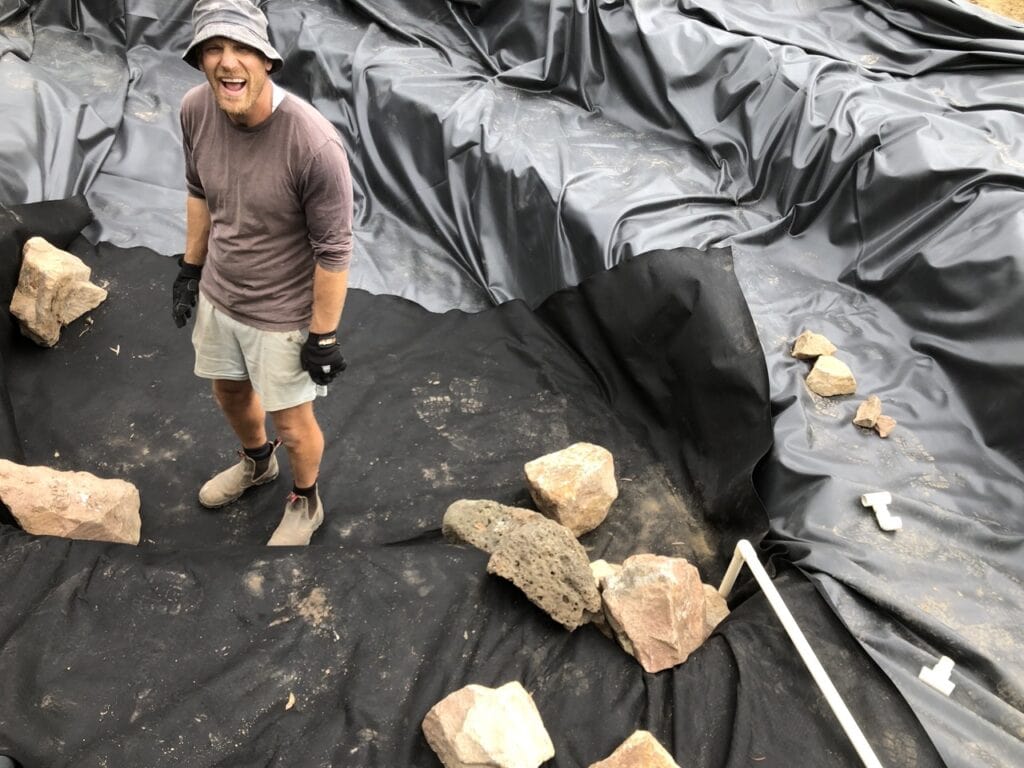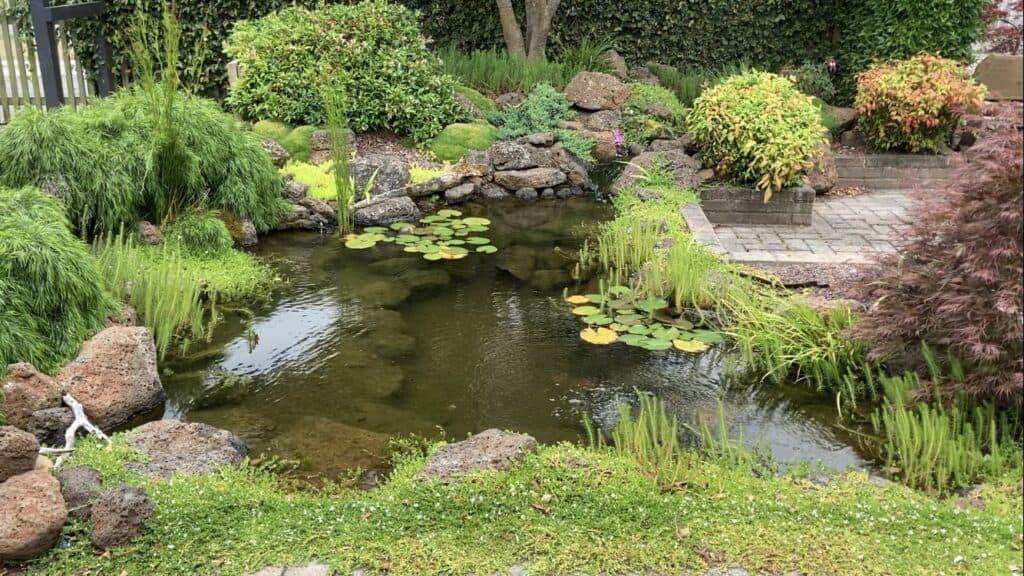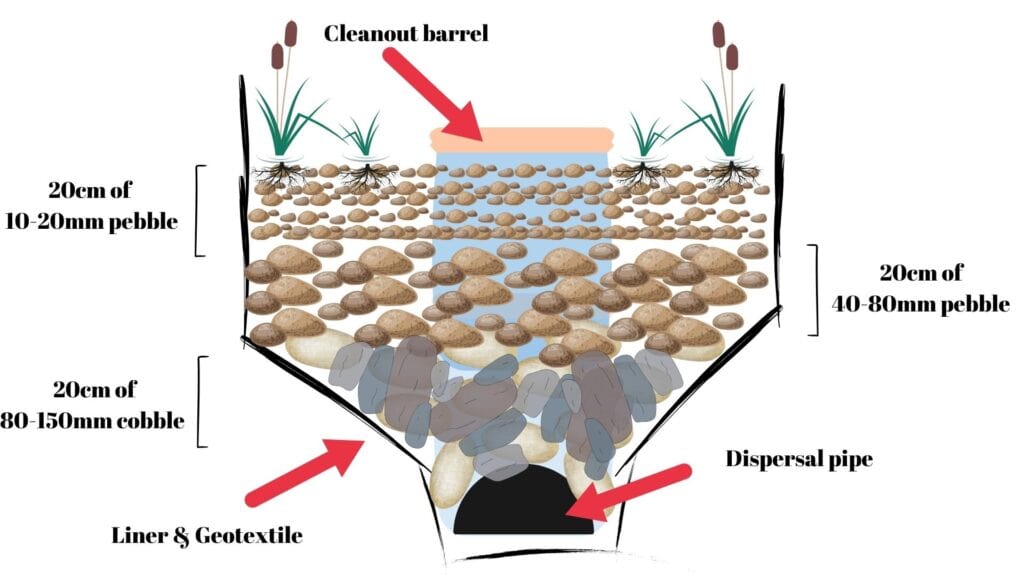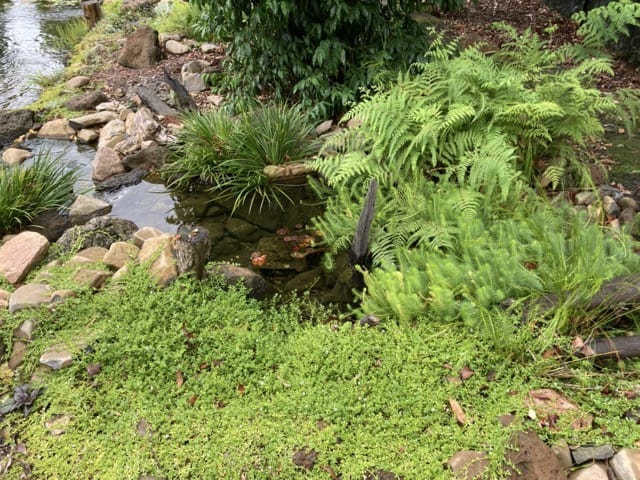A bog filter is a biological filter that provides a safe place for beneficial bacteria to thrive. These bacteria process nitrogen and phosphate, which are key in maintaining clean water.
Additionally, plants in the bog filter further reduce nutrient levels and trap sediments. Essentially, a bog filter acts like a natural wetland. I believe a bog filter is one of the best filters for maintaining clean, clear, healthy water.
👉 And if you’re just getting started, I also put together a free pond planning checklist, bog filter calculator, and pump flow rate calculator — you can grab them all in one easy bundle. It’s a great way to plan your setup without the guesswork.
Key Benefits of a bog filter:
- Incredibly Effective: It’s a highly effective biological filter and a decent mechanical filter.
- Low Maintenance: Properly sized and built, it requires minimal maintenance.
- Aesthetically Pleasing: Can blend into the landscape or look attractive on its own.

Blueprint I use to build my ponds
- All the numbers I use to design my ponds, delivered straight to your inbox
- These formulas have helped people all over the world build beautiful, low maintenance ponds, without spending a fortune.
- Access to a private community of like minded people and a chat bot that loves answering pond related questions.
Designing and Building Your Bog Filter
Size Matters:
For a simple goldfish pond (small, not overly stocked or fed), the bog filter should be 10% of the pond’s volume. For example, a 1,000-liter (264 Gallons) pond needs a 100-liter (26 Gallon) bog filter.
Larger fish or more fish require a larger bog filter, potentially up to 25% of the pond’s volume for fish like koi or ponds with ducks.
I believe there’s no such thing as oversizing the filter, so don’t be shy.
Here’s a link to another article I wrote that goes into more details on size.
Materials:
You can build a bog filter from various materials like plant pots, old drums, storage crates, stock tanks, water troughs, or even bathtubs.
On my products page, you can find some helpful resources and products that are useful, when building a bog filter.
Below are some videos that show different sized bog filters and how I constructed them. You can also take a look at some of the ponds these are filtering and how the entire projects came together, if you’re interested.
Flow rates:
A bog filter likes a reasonably slow flow. I find that I size my pump or pumps at 6 times the empty volume of the bog.
Example: If the bog filter is 1000L (250gal), I would buy a 6000L (1500gal) per hour pump. This will allow for some head loss and pipe friction. My helpful pdf goes into more details.
You’ll also want an energy efficient pump to keep running cost low. The filter should run 24/7. You can see the types of pumps I like to use on the helpful products page.
Water Flow Configuration:
Upflow Method: Water is pumped into the base of the bog filter and rises through the rocks and pebbles, ensuring all water contacts the beneficial bacteria.
Downflow Method: Less preferred as water may take the path of least resistance, bypassing some filtering material.
Heres a video where I talk about the pros and cons of each. Or if you prefer to read and article you can click here.
Plumbing:
The easiest way to configure the bog is so that the water level in the bog, sits higher than the water level inside the pond. This allows water to be pumped from the pond, up into the bog filter, and then gravity carries it back into the pond.
I think two of the most important plumbing points are:
Avoid Siphoning: Bring the plumbing over the top of the filter and down into the base to prevent backflow if the pump stops. If the pump shuts off we don’t want the filter to siphon back into the pond.
All the muck it has trapped will flow back into the pond. To achieve this I add a breather hole, Here’s a video showing a breather hole and explaining it’s importance.
Overflow Size: Ensure the overflow pipe, is larger than the inflow pipe to handle the water flow without pressure issues. When water is pumped into the filter it is under pressure, this means more water fits into a smaller area.
As the water leaves the filter it is no longer under pressure, that means that if it is leaving the filter via a pipe it needs to be bigger.
In my downloadable pdf I talk about plumbing sizes. Usually I simply size the inflow into the filter at the largest size the pump manufacture recommends.

Join my free email list
If you would like to join my free email list click the button below.
I promise I won’t spam you, I’ll only send information I think can help you save money building and maintaining a pond.
Cleaning:
From time to time it will be necessary to drain and flush the filter. The beauty of a properly sized bog is this is only really needed once or twice a year.
There’s two main ways I make my filters easy to clean:
Drain Valve: A valve at the base, allows easy draining and cleaning of the filter. More useful on smaller filters built using containers.
Access Points: For larger filters, an access point for a pump or pond vacuum can be useful.
Here’s a video on how I clean a bog filter.
Rock and Pebble Layers:
Use larger rocks at the bottom, progressing to smaller pebbles at the top. This setup provides ample surface area for beneficial bacteria to grow.
Layering the rock in this way, I think makes the filter easier to clean and maintain.

Plants:
Choose plants that are easy to thin out. Avoid aggressive roots that can block the filter.
Because we all live in different parts of the world, what works for me might not work for you.
I did write an article on 40 awesome pond plants, it has a bog filter section and I’ve tried to include fairly common plants that I believe are available in most areas.
Water Level:
Shallow water over the bog can lead to algae growth and mosquito breeding. Ensure the last layer of pebble is higher than the water level if this is a concern or have deeper water that can keep fish.
Pump Position:
For small ponds, place the pump in the pond and circulate the water back to the bog. Elevate the pump slightly off the pond’s bottom to prevent emptying the pond in case of a malfunction.
I also like to place the pump in a small pot and cover it with a coarse filter sponge.
In larger ponds I strongly recommend the use of a negative edge, skimmer or Intake bay. Here’s a video that explains how they work.
Final Thoughts
Building and maintaining a bog filter doesn’t need to be complex or expensive. By following these guidelines, you can enjoy a clean, clear pond with minimal effort.
Did I mention? If you want to build a natural looking pond that is easy to maintain, you may like to purchase my helpful PDF with formulas.
I hope this article was helpful, thank for reading. Good luck with your pond project.

Join my free email list
If you would like to join my free email list click the button below.
I promise I won’t spam you, I’ll only send information I think can help you save money building and maintaining a pond.

